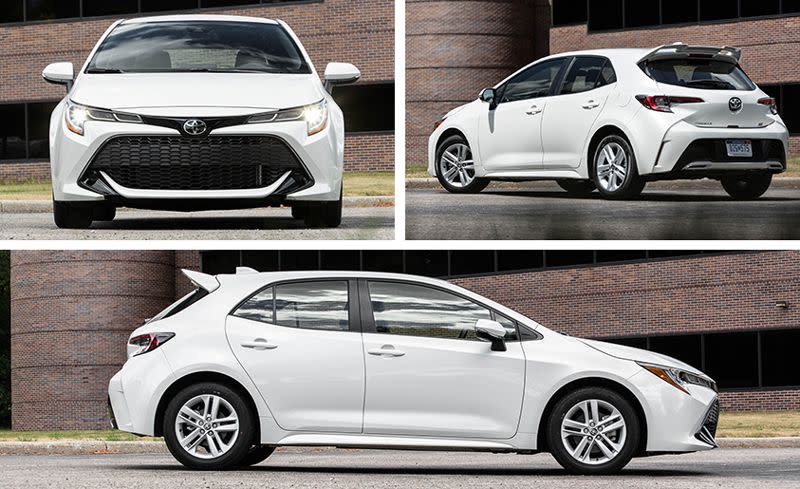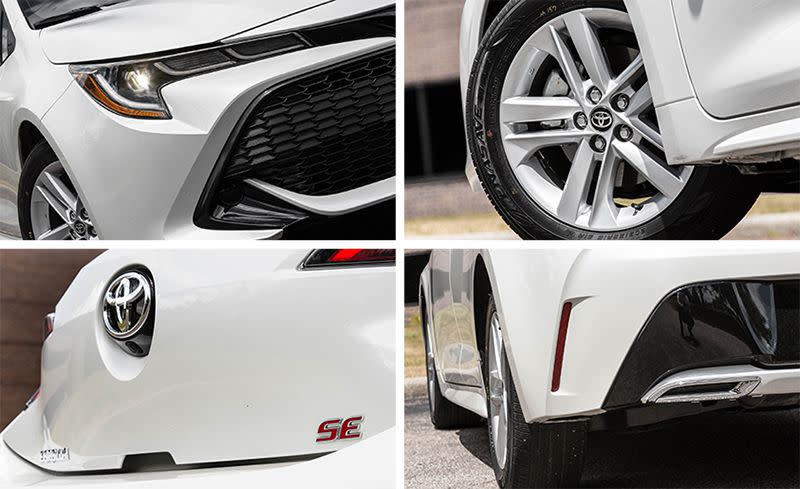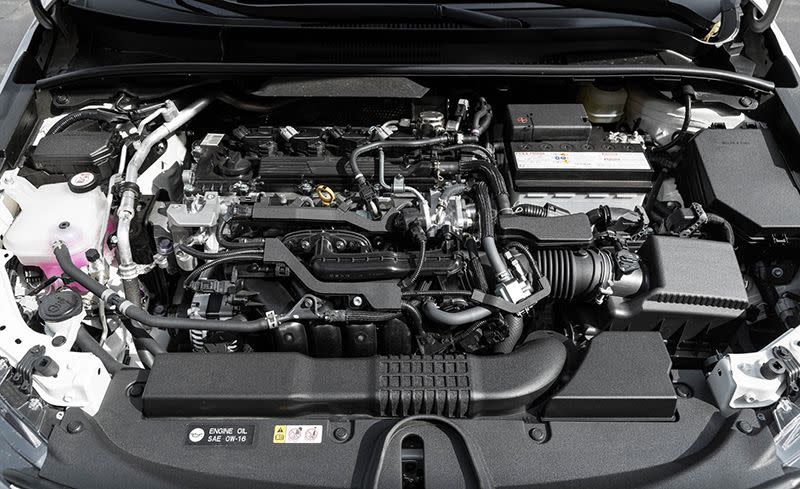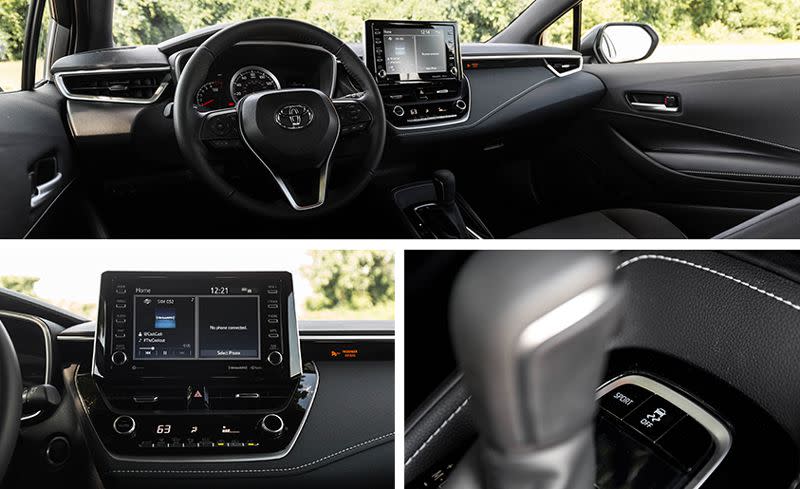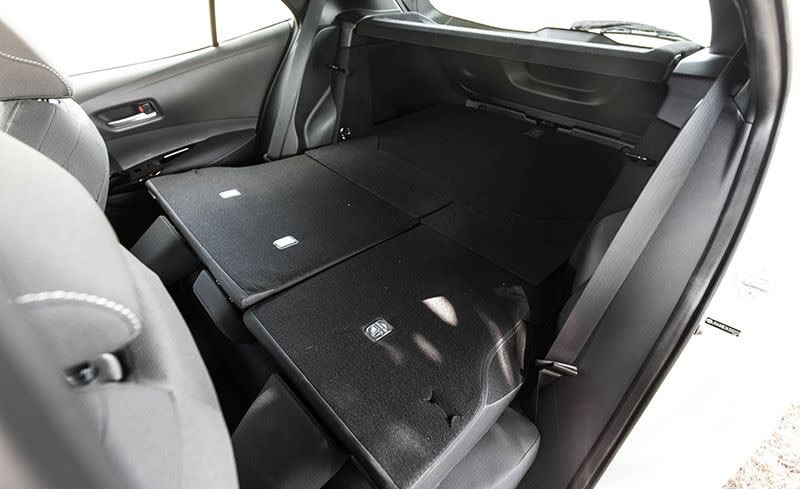The 2019 Toyota Corolla Hatchback Belies Its Reputation
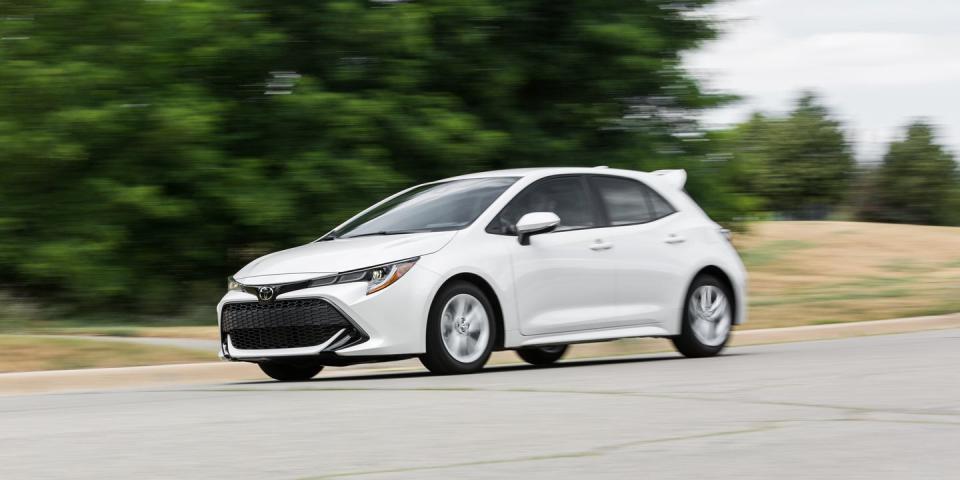
The Corolla is Toyota’s third-longest-serving nameplate behind the Land Cruiser and the not-for-the-U.S. Crown. Given its decades-long tenure, most Americans-and consumers across much of the globe-know pretty well what a Corolla is. It’s an inexpensive and economical small car, sturdy and reliable but utterly devoid of frills and thrills.
Although selling boring but reliable cars has been a winning strategy for Toyota, it’s also an unexciting one, and CEO Akio Toyoda has been pushing for more interesting products. The results of that effort have now reached the hatchback version of the Corolla, which has been redesigned for 2019. An as-yet-unseen overhauled version of the far more popular sedan is on the horizon.
The hatchback model replaces the Corolla iM (née Scion iM) and, like that car, is sold under the Auris name in Europe. The new car is longer and wider than the iM, and it sits astride a slightly longer wheelbase and has wider front and rear tracks. Combine those revised proportions with attractively folded sheetmetal, and you have an aggressive-looking compact hatch. Two trim levels are offered: SE and XSE. The latter is more visually appealing, with sharp-looking 18-inch wheels and slightly different exterior trim; our test car was the more basic SE, rolling on 16s and with a hatch-top spoiler that, frankly, is the one aggressive element that looks out of place.
Who You Callin’ CVT?
Although the Corolla hatchback offers-in both its trim levels-a six-speed manual with rev matching, our test car was equipped the way the vast majority of Corollas will be: with an automatic. More specifically, the transmission is a continuously variable automatic (CVT), but it’s one that goes to extraordinary lengths not to behave like a traditional CVT. First of all, it’s supplemented by an actual fixed-ratio first gear, beyond which the continuously variable portion of the transmission takes over. Even so, its programming is designed to mimic a conventional gearbox, shuffling through 10 preset ratio steps.
The fixed first gear means that the response when pulling away from a stop is exactly the same as with a normal automatic, as it never sends the needle zooming across the tach to park itself near the redline while the engine waits for the car to catch up. And even once you’re out of first gear, the transmission does a mostly convincing job disguising its type, with revs rising and falling in steps. This novel setup almost entirely eliminates the elastic throttle response and concurrent engine droning that plague most CVTs.
Engage the Sport mode via a button near the shifter and the engine spends more time in closer proximity to its torque peak, which in this naturally aspirated inline-four is up at 4800 rpm. That further aids throttle response but also locks out the tallest ratios, keeping the engine spinning at 3000 rpm at 75 mph, whereas switching off Sport mode brings that down to 2400 rpm or so. Drivers also can use the standard shift paddles or the shifter’s plus/minus gate to exercise more control over the proceedings. Shout out, by the way, to that traditional, mechanical shift lever, which is so simple, so intuitive, and so preferable to the funky electronic wands and oddball shift patterns found in so many other Toyotas. How did the Corolla escape that thing?
Four with More
The CVT distills the output of a new four-cylinder engine. Displacing 2.0 liters, it’s bigger and more powerful than the 1.8-liter weakling in the Corolla iM. Horsepower stands at 168 versus the previous 137, while its 151 lb-ft of torque is 26 lb-ft greater than before. (Read more about the new engine and CVT here.)
In our testing, the 2.0-liter sent the Corolla hatchback scampering to 60 mph in 8.3 seconds, 0.8 second quicker than the previous CVT-equipped Corolla iM and just behind the 8.0-second Hyundai Elantra GT hatch. But it’s still far afield of the more powerful, turbocharged, automatic-equipped offerings at the head of this class: the Honda Civic Sport (180 horsepower, 6.9 seconds) and the Volkswagen Golf (170 horsepower, 7.7 seconds). It also trails the Chevy Cruze hatchback, with its 153-hp turbo 1.4-liter, at 7.7 seconds. And hard acceleration in the Corolla reveals an engine note that’s fairly gritty, although the four-banger is well muffled in gentler cruising.
Still Drinks like a Corolla
One area where the Corolla does not stray from its image is in its abstemious appetite for fuel. The SE hatchback earns EPA estimates of 32 mpg city, 42 highway, and 36 combined. (The XSE, with its bigger wheels and stickier rubber, comes in at 30/38/33.) The SE’s numbers trounce the Golf’s EPA figures by 8 mpg in the city and 9 on the highway, and it edges the Civic by a narrower 1 to 2 mpg. On our 75-mph highway fuel-economy test, we saw 40 mpg, which is slightly worse than the Corolla’s EPA rating but better than we achieved in the lower-rated Civic (37 mpg) and Golf (36 mpg).
The new Corolla boasts a quiet ride, which helps impart a newly premium feel. At a steady 70 mph we measured 69 decibels, tying the Cruze as the quietest in this segment. The suspension of struts in front and a sophisticated-for-this-class multilink arrangement at the rear does a fairly good job of masking potholes, although frost heaves are acknowledged with a quick upkick. Most bumps barely register, though, and the structure’s evident solidity lends credence to Toyota’s claim of a 60 percent increase in body rigidity compared with the iM.
The Corolla also transcends its image and history in its steering. Although still electrically assisted, it’s no longer limp and overboosted but instead feels appropriately weighted and reasonably precise. Bend the Corolla into a corner, and the chassis does not cover its eyes in fear at the sight of the curve, instead responding gamely and seeming to turn in more sharply the more energetically the car is driven. Toyota claims the center of gravity for the 2019 Corolla is 0.8 inch lower than for the iM and that both the front and rear suspensions have been revised to reduce friction. That the Corolla recorded a middling 0.81 g of grip on our skidpad is more a function of its eco-focused rubber than any limitation of the chassis. Those tires also contributed to a disappointing stopping distance of 183 feet from 70 mph.
Nice but Cozy
The interior-a dour warren of hard plastic in recent Corollas-is quite attractive and tasteful in the new hatchback. The dash and door panels are upholstered, not just stamped out of plastic, and both the door armrests and the adjustable center armrest are nicely padded. The steering wheel is wrapped in smooth leather, and the center console looks upscale with gloss-black and brushed-metal accents. Our car’s interior was solid black, but a gray and black two-tone scheme is available. An 8.0-inch central touchscreen with sharply rendered graphics is standard on the SE, and it’s supplemented by knobs and buttons, all of high quality. It’s a cabin with more pizazz than you’ll find in most competitors-not something that has ever been true of past Corollas.
If only there were a bit more to it. The Corolla casts a shadow 2.4 inches longer than a Golf and sits on an almost identical wheelbase, but it feels far more cramped inside. The front of the cabin is not too bad, although the fast-sloping windshield and rather steep tumblehome bring the A-pillars in fairly close. But rear-seat leg- and kneeroom barely allow for an adult to squeeze in behind a six-foot driver, and access to the rear seat is through a narrow door opening. Thick B- and C-pillars, a smallish backlight, and a beltline that kicks up at the rear conspire to restrict the view out of the sides and rear. The highly stylized rear quarters stand in contrast to boxier hatchbacks, but pop the liftgate and the downside to the Corolla’s expressive design becomes obvious. There are just 18 cubic feet behind the rear seats, less than you’ll find in the Golf, Cruze, Civic, or Mazda 3. The space can be expanded by dropping the seatbacks, but the load floor is surprisingly high, almost like that of an SUV.
Still, this Corolla’s tight quarters are a far more pleasant place to spend time than was the case for any previous Corolla. There’s nothing in here that feels cheap despite the fact that this car is affordable: $20,910 to start and $22,010 with the CVT. Granted, that price isn’t quite as inexpensive as before, as the previous Corolla iM could be had for as little as $19,770. But the new car is much better equipped, with standard features that include proximity entry and push-button start, automatic climate control, LED head- and taillights, the aforementioned 8.0-inch touchscreen, Apple CarPlay, adaptive cruise control with lane-keeping assist, precollision warning with pedestrian and cyclist detection, automated emergency braking, and lane-departure warning. Our test example had all available SE options, including the CVT, $395 Blizzard Pearl paint, and the $1400 Preferred package that adds blind-spot monitoring and a more advanced version of the Entune infotainment with an upgraded audio system, satellite radio, and more connectivity functions.
While the Corolla hatchback doesn’t have the beans to challenge the segment’s hot-hatch elite and it’s far from the roomiest in this segment, its interior finish and level of equipment are shockingly good for a car at this price. This model exudes a newfound sophistication and style heretofore unknown for the humble Corolla. That sophistication extends to the unusual automatic transmission, and while the manual still would be our preference, this CVT ends up being better than expected-much like the Corolla hatchback itself.
('You Might Also Like',)

 Yahoo Autos
Yahoo Autos 